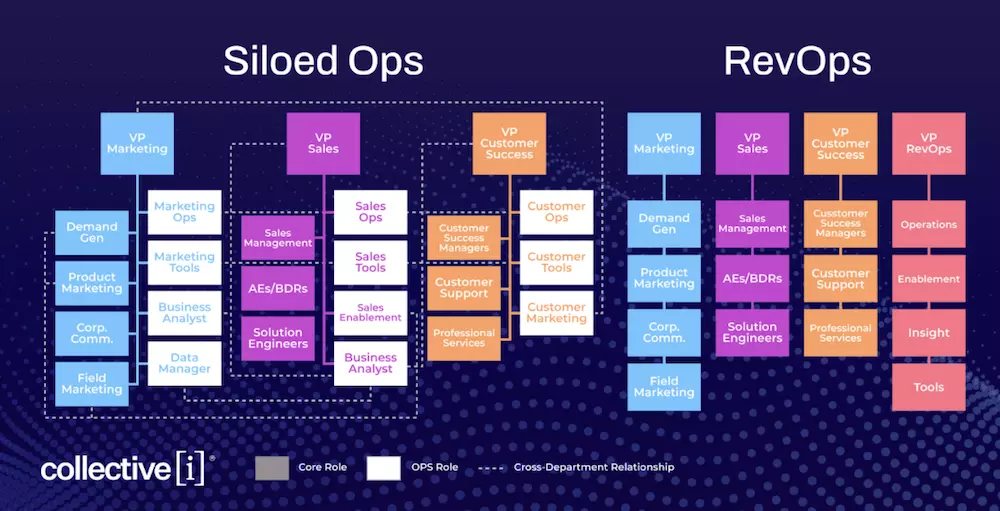Sales, marketing and customer success — all of these aspects of business are moving in the same direction, right? Well, not necessarily. A recent survey found that almost half of businesses have not fully aligned their departments in the task of securing revenue opportunities, while over two-thirds said that sales, marketing, customer success and other departments are using different metrics to measure the customer journey.
This kind of disconnect represents an enormous inefficiency for companies, eroding their revenue and impeding growth. But it also presents a huge opportunity, because fortunately there is a way to overcome this obstacle: by leveraging the integration and unification of a RevOps strategy.
Introduction to RevOps
So what is RevOps, exactly? RevOps stands for Revenue Operations — a strategy that integrates the sales, marketing and customer success departments within a business. When these departments are aligned, they can be managed and administered as a unified whole, supporting more effective revenue generation.
While the processes and operations are aligned within a revenue ops strategy, they are still handled by teams within each individual department. This means there is no need for a total operational overhaul, and teams can continue to fulfil their existing roles while working with a unified resource of data and best practices. Cross functional teams and unified deal desk processes can be created, but the individual departments retain operational independence. Win-win!
What Problems Does RevOps Solve for Businesses?
On a conceptual level, RevOps helps to eliminate the misalignment of strategic goals — i.e., the disconnect between different departments. If the sales team, marketing teams and customer success departments are unified, it’s easier to ensure that all these areas of the business are moving towards the same goals.
A revenue operations model solves more practical problems too. With a solid revenue operations strategy, businesses achieve a single source of truth from which to measure and assess progress. This means teams are able to track unified KPIs and metrics, keeping all departments on the right track.
This unification also extends to technology. When technology stacks are misaligned, this leads to significant performance discrepancies between departments. RevOps solves this problem by integrating process management and tech usage best practices between separate departments, from sales operations to customer services.
Implementing RevOps Within Your Business
Any business that is scaling its sales team, marketing team and customer success departments will benefit by adopting a RevOps strategy. Without this strategy, growth effectively becomes siloed — departments follow their own growth frameworks and work towards targets that are not aligned with one another. Revenue will suffer as a result.
RevOps process implementation can be challenging. It may be necessary to deploy a dedicated RevOps team, for example, something that will require top-down investment and a reorganisation of business funds and resources. C-suite level engagement will also be necessary, ensuring that the strategy has backing from revenue leaders in the uppermost echelons of the business.
Revenue Process — How Does RevOps Work?
RevOps works according to six pillars that form the basis of the strategy.
1. Data
Data underpins the entire RevOps strategy. This is the resource that will deliver insight into revenue generation and that will provide the means to measure KPIs.
RevOps teams need to remain aware of the health and integrity of data, as well as data infrastructure, administration and stewardship. This means drawing upon the relevant datapoints for measurement and monitoring, while also ensuring that data is securely stored and immediately accessible when required.
2. Customer Processes
Customers are the key revenue drivers for your organisation, so customer processes need to be at the heart of a unified revenue operations strategy.
An effective RevOps strategy will optimise the customer journey, aligning the customer success department with the sales and marketing departments to ensure a seamless path. Sales processes and customer segmentation will also need to be aligned. Quarterly reviews, and renewal and expansion of the strategy, will be delivered and executed by the central RevOps team.
3. KPIs & Reporting
As touched on above, RevOps hinges on the adoption of common KPIs across the sales, marketing and customer success departments. Each department will be able to utilise these KPIs to commission standardised reports that provide operational insights for different teams within the revenue process.
In addition to shared KPIs, teams will adopt shared business development goals and forecasting best practices. Sales performance data, account retention and expansion data, and pipeline management processes will also be handled by the central RevOps team and overseen by revenue management leaders.
4. Tech Stack
This is something we’ll explore in more detail later on, but RevOps depends upon the deployment of the right technology. Developing a tech stack involves evaluating needs, acquiring the proper technology and then conducting administration and integration ahead of utilisation by RevOps professionals.
5. Enablement
People are at the heart of the RevOps strategy. These individual team members may execute sales rep or customer service operations, but they all need to be developed, trained and coached so that they can operate effectively within this new revenue marketing approach. They will also need to be supervised by a RevOps professional. Onboarding of new team members must be reconfigured to support ongoing revenue enablement.
6. Strategic Insights & Planning
RevOps teams draw upon available data to identify revenue opportunities and target accounts. The team also uses KPIs and key metrics to set objectives and goals for the RevOps strategy.
All of these individual elements must be unified across the three departments. For instance, the KPIs you use for generating revenue must be the same for the sales team as for the customer success team. Fostering integration and seamless transition between sales operations, marketing operations and other departments depends on the RevOps implementation model you choose, as well as the tech solutions you deploy during utilisation — we’ll discuss these models and technology in more detail below.
Revenue Technology
Successful RevOps implementation requires the right toolkit. Without the right set of revenue intelligence software solutions by your side, it becomes difficult to achieve the profound levels of alignment and integration needed to leverage the best from RevOps.
Your RevOps Toolkit
So what do you need to include in this toolkit? There are several solutions you will need to consider as you build your RevOps approach.
Customer Relationship Management (CRM) software
CRM solutions provide end-to-end insight into sales operations and acquisitions processes, extending this through to customer service and retention ops. In this sense, CRM software becomes a must-have for customer data handling and revenue operation success.
Routing Automation Software
Routing automation helps to achieve effective account based marketing. This software supports the marketing strategy by removing the labour from managing call flows while drawing on machine learning capabilities to identify high-value accounts. This is a vital part of optimising customer revenue.
Reporting Tools
Reporting tools are key pieces of revenue intelligence software, delivering data insight from the sales cycle. RevOps teams need to adopt a combination of real-time data analysis and reporting in order to achieve the proper foundation of knowledge and understanding.
Board Management Software
RevOps requires engagement at all levels of the business. Board management software supports this focus on director revenue operations, helping teams to organise meetings with C-suite level personnel while also setting realistic targets and deadlines.
Payment Integration Software
Payment integration software translates data from payment channels and gateways in a secure and reliable fashion. Once integrated into the broader RevOps ecosystem, this data provides useful insight for revenue operations teams as you target more predictable revenue.
Choosing Your RevOps Solutions
Selecting revenue intelligence software is a personal choice, and will depend on the structure of your business. To decide on which solutions to use, examine the following points.
- Gaps in your current setup — What problems are you experiencing with making a sale, marketing effectively and achieving effective customer service? For instance, if you are struggling to eliminate data siloing between departments, an overarching CRM solution might be a priority. If you are finding it hard to provide a strong customer experience, your customer success department may lack the required data.
- Your current budget — Budgeting is always a concern for you and your ops teams, but you should also consider the ROI of each potential solution.
- Testing and free trials — Does the solution have a free trial option? This can give your revenue generating teams the chance to learn more about its features and decide which software is best on the way to achieving your revenue goals.
Revenue Intelligence
The idea of a data-driven business operations has been around for quite some time, and the Big Data concept has been in its third phase since 2010. However, data interpretation is becoming increasingly valuable for businesses, as increasing numbers of organisations implement their own insight-based RevOps processes — the number of companies with a RevOps strategy grew by 15% in 2021, with a further growth of 11% expected this year.
Data is critical to RevOps because revenue intelligence depends on confidence and certainty rather than speculation.
Departments don’t just need to be tracking the same metrics and KPIs as they nurture leads and deliver a strong customer experience. Instead, they need to be tracking the right ones — analysing the datapoints that provide the most valuable insight as you target your revenue goal and optimise the customer journey.
These revenue intelligence KPIs include:
- Cost of Customer Acquisition
- MRR/ARR
- Renewals
- Upsells/Cross-Sells
- Customer Satisfaction and Customer Churn
- Lifetime Value (LTV)
- Forecast Accuracy
- Pipeline Velocity
- Sales Cycle and Sources of Recurring Revenue
- Win Rate
- Lead Relationship
- Lead Score
- Opportunity
- Relationship Score
- Account Relationship
- NPS
- Revenue Per Employee
To ensure sales data integrity and to target predictable revenue growth, the revenue operations manager and team will need to focus on the following:
- Implementing the right revenue intelligence platform and revenue intelligence software tools
- Unifying the project with a chief marketing officer or another member of the management team
- Ensuring all personnel within the revenue team have the training and competency they need
- Carrying out regular data audits and process audits across the revenue intelligence environment
- Measuring responses on an ongoing basis, making sure that projected targets are in line with customer reality
- Prioritising security and full regulatory compliance when handling data
Implementing RevOps — Optimise for Revenue
While there is a standardised central concept for RevOps, there is no single standard for implementation. Instead, this implementation can be handled in different ways.
Businesses may decide to implement RevOps as a core tenet of company culture — fostering an environment of communication and collaboration in which all members of sales, marketing and customer success departments are responsible for adopting and overseeing RevOps processes.
Alternatively, the business’s Chief Operations Officer (COO) is made responsible for unifying and aligning departments together as one whole. This COO orchestrates and aligns the individual department teams.
The business may instead decide to appoint a Chief Revenue Officer (CRO), who is dedicated to overseeing the RevOps framework either alongside the COO or independently.
Choosing the Right RevOps Model
Selecting the right RevOps model for your business largely depends upon the size of your organisation, your available resources and your management structure.
Smaller businesses may find it more suitable to build RevOps into their culture and identity, fostering a revenue operations focus across all team members. Larger businesses with totemic departments dedicated to sales ops, marketing ops and customer success may require the oversight of a COO, a CRO or a combination of the two.
The RevOps Team
While all of your sales, marketing and customer success personnel will be engaged with the revenue operations process, you will need a RevOps team to oversee this. The structure of this team will depend on the implementation model listed above, but you are still likely to centre your efforts on several key revenue ops team members. Each team member will have different revenue operations titles that define their roles.

Revenue Operations Leader
In most cases, you’ll need a revenue operations leader who will oversee operations management implementation and utilisation within your revenue generating team. This may be a designated RevOps manager, or it may be the COO or CRO depending on your model of implementation. The leader will be responsible for interdepartmental integration and ensuring smooth transitions and collaborations between these departments. Selecting a leader from the C-suite executive level also ensures that personnel have the authority to make required operational changes.
Department Leaders
At the very least, you’ll need RevOps team members from each of the integrated departments — sales, marketing and customer success. These GTM team leaders will be responsible for overseeing operations within their individual departments, but this internal team will remain aware of how these ops impact those of other departments.
Department Implementation Assistants
Depending on the size of your business and the scale of the project, you may need to enlist other personnel from each of the three integrated departments to serve as implementation assistants.
The Benefits of RevOps
Implementing the RevOps framework connects businesses with a range of benefits.
Unified, Aligned Departments
The most obvious benefit of RevOps is interdepartmental alignment. All GTM teams — from sales, traditional and digital marketing, and customer success departments — are drawing from the same data, utilising the same metrics, and working towards the same ends. Disconnection and misalignment are effectively eliminated.
Streamlined Operations
With no miscommunication or disconnection between departments, everything becomes much more streamlined. Existing processes can be either automated or made more streamlined to support better operational efficiency.
A Solid Foundation of Insight
RevOps processes are based upon data, utilising sophisticated tools for gathering, interpretation and storage. By bringing revenue intelligence data together in a central source of truth, RevOps ensures that there is no siloing of insight within individual departments and provides comprehensive access to all who require it.
Improved Customer Retention and Lifetime Value
As customer success operations are an inherent part of the overarching RevOps structure, both ends of the customer life cycle are protected. Rather than simply bringing in new customers, RevOps teams enhance the customer experience to better retain existing clients and to augment their full lifetime value, while still achieving the required levels of customer acquisition.
Accelerated, Sustainable Growth
Business growth is one of the key targets of the revenue operations team. By identifying and developing opportunities with unified revenue operations processes, businesses achieve a predictable revenue stream that supports swift yet sustainable growth.
RevOps Education — Learn More About RevOps
As you implement RevOps within your organisation, you will develop an understanding of how revenue ops works in line with the unique structure of your business. Google Analytics and other data-focused tools can provide concrete proof of the success of RevOps, which is certainly useful in supporting company-wide engagement in the process. However, it is also useful to become certified and to grow your understanding in other ways.
Getting Certified in RevOps
Those just starting out with RevOps can take the free HubSpot Revenue Operations Course, providing a background for implementation and ongoing development.

More advanced courses, such as RevOps Co-op and Pavilion courses, will require a fee, subscription or membership before you can gain access. However, these courses may be useful for professionals seeking to take revenue intelligence to the next level.
Growing Your Understanding
It’s always helpful to remain engaged with the latest developments in RevOps best practices and understanding. With this in mind, RevOps podcasts are useful resources for information and ideas.
The Sales Hacker podcast, as well as Revenue Innovators produced by the same team, are popular choices for professionals in this field. The Sales Tech podcast is also valuable for anyone searching out new forms of technology to support revenue-generating teams and sales enablement efforts.
If you are looking for some variety outside of the podcast format, thought leaders in the field are releasing useful articles and other resources as part of their content marketing initiatives. Salesforce and HubSpot both regularly release RevOps and revenue intelligence related content that can help businesses gain a better picture of how RevOps can transform their operations.
Exploring RevOps and Its Potential
To explore RevOps in greater detail, take a look at some of our content pieces on the finer points of revenue operations integration, implementation and utilisation, or reach out to our team to discuss how this can work for your business.










